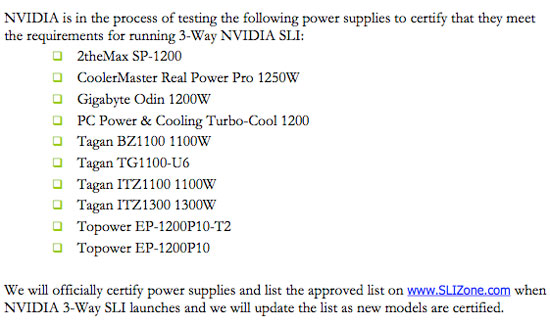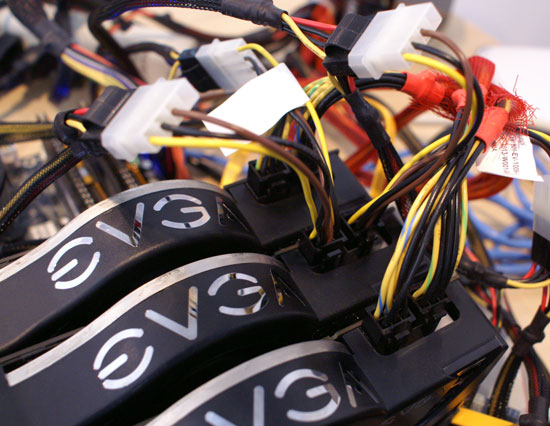NVIDIA's 3-way SLI: Can we finally play Crysis?
by Anand Lal Shimpi on December 17, 2007 3:00 PM EST- Posted in
- GPUs
NVIDIA is in a difficult position. On one front it has the chipset division of AMD, fighting hard to make its own chipsets the platform of choice for AMD processors. On the other front it has Intel, the enemy of its enemy, and a very dangerous partner itself. Intel hasn't been very quiet about its plans for dominating the GPU market, but that isn't for another couple of years, until then, Intel will gladly allow NVIDIA to make chipsets for its processors.
As a company, NVIDIA needs to be able to maintain relevancy in the market. In the worst case scenario, AMD and Intel would each make their own chipsets and graphics cards, leaving NVIDIA with nothing to do. The reality is that NVIDIA still has the best graphics cards on the market and neither AMD or Intel is anywhere close to taking the crown yet. The chipset business is more likely in imminent danger, but NVIDIA does have one trick up its sleeve: SLI.
NVIDIA has some very desirable graphics cards, and it has a tremendous brand in those three letters. Of course, SLI only works on NVIDIA chipsets, thus it's no surprise to see NVIDIA trying to add even more value to the SLI proposition.
The GPU manufacturers, in the past two years, started to run into the same sort of thermal walls that Intel did during the Pentium 4 days. Future GPU designs will be more focused on power consumption and performance per watt, and while that won't kill the very high end graphics market, it will undoubtedly change it. If you'll notice, the first two G92 based products NVIDIA launched were both targeted at the mid range and lower high end segments, there were no 8800 GTX/Ultra replacements in the cards.
It may end up being that the way NVIDIA pushes the envelope isn't by introducing single, very powerful GPUs, but rather by SLI-ing lesser GPUs together. That brings us to today's topic: 3-way SLI.
If you can't tell by the name, 3-way SLI is like conventional 2-card SLI but with three cards.
The requirements for 3-way SLI are simple: you need an NVIDIA 680i or 780i motherboard, and you need three 8800 GTX or 8800 Ultra cards. SLI support continues to be the biggest reason to purchase an NVIDIA based motherboard, thus it's no surprise to see 3-way SLI not work on any competitor chipsets. With three cards you need two SLI connectors per card, meaning that all of the recently released G92 based boards won't cut it.
The graphics card limitations are quite possibly the most shocking, because the 8800 GTX and Ultra are still based on the old G80 GPU, which is significantly hotter than the new 65nm G92 that is used in the 8800 GT and GTS 512. NVIDIA unfortunately only outfitted those new G92 cards with a single SLI connector, so 3-way SLI was out of the question from the start and plus, NVIDIA needed some reason to continue to sell the 8800 GTX and Ultra.
Power supply and cooling requirements are also pretty stringent, NVIDIA lists the minimum power supply requirements as:

And a list of 3-way SLI certified power supplies follows:

We actually used an OCZ 1000W unit without any problems (including two 4-pin molex to 6-pin PCIe power connectors to feed the third card), but we'd recommend sticking to NVIDIA's list if you want to be safe.

The three cards are connected using a new SLI bridge card that ships with all 780i motherboards:

If you don't have this card you can jerry rig a bridge using regular SLI flex cables in the following configuration:











48 Comments
View All Comments
kilkennycat - Tuesday, December 18, 2007 - link
...it's far more likely to be used by a (nV) video card functioning as a GPGPU for either gaming --- or in the short-term --- professional desktop applications. nV is making great strides in the professional scientific number-crunching and signal-processing communities with their CUDA toolset running on their current GPU offerings. They currently own ~ 86% of the "workstation graphics" market, but in a rapidly-increasing number of cases, graphics is not the sole function of the current nV workstation hardware. Wait for nVidia's next generation silicon and driver software which will be far more focussed on seamlessly merging GPU and GPGPU functionality. Also, wait for their true next-gen motherboard chip-set and not the cobbled-together "780i" which will implement symmetrical PCIe2.0 on all 3 PCIe x16 slots. Arriving about the same time as their next gen GPU family. Mid-2008 would be my guess.aguilpa1 - Tuesday, December 18, 2007 - link
Funny how your review doesn't address this blatant issue. yes it will run tri sli but don't expect it to do with the same Yorkfield used on the test board they used. Engineering samples of the QX9650 ran fine on the 680i SLI's but were changed with the retail versions. Whether it was Intels pissy way of getting back at Nvidia for not licensing SLI to them or Nvidia's way of making a buck off of selling an almost already obsolete board (nehalems coming next year). At this stage...who cares.ilovemaja - Tuesday, December 18, 2007 - link
that quote: His response? "JESUS". "No", I said, "not even Jesus needs this much power".Is one of the funnyest things i heard in my live.
Thanks for another good article, you are the best.
acejj26 - Tuesday, December 18, 2007 - link
In Crysis, you say that the third card offers a 7% performance boost over the 2 card configuration, however, it is only offering 1 fps more, which is just about 2%. Those numbers should be changed.Sunrise089 - Tuesday, December 18, 2007 - link
Not complaining, but I've noticed the last several GPU articles have been written by Anand, which isn't his normal gig. On top of that we get a reference to another GPU editor from back in the day. What's up?compy386 - Tuesday, December 18, 2007 - link
I'd be interesting to do a comparision between SLI and Crossfire once AMD gets some drivers out that actually support quad SLI. I saw a board on newegg that looks like I'd fit 3 3870s as well.AcydRaine - Tuesday, December 18, 2007 - link
AMD doesn't support "Quad-SLI" at all. There are a few boards on Newegg that will fit 4x3780s. Not just 3.compy386 - Tuesday, December 18, 2007 - link
The 3870s take up 2 slots so I only see boards that fit 3. Most of the boards will take 4 3850s though. Again, I'd like to see the performance number comparisons for scaling purposes.compy386 - Tuesday, December 18, 2007 - link
The 3870s take up 2 slots so I only see boards that fit 3. Most of the boards will take 4 3850s though. Again, I'd like to see the performance number comparisons for scaling purposes.SoBizarre - Tuesday, December 18, 2007 - link
Well, I’m glad to see this evaluation of 3-way SLI. It just gave me an idea about overcoming performance issues in games like Crysis. There is no need for building ridiculously expensive machines which draws insane amount of power. I have a better solution (although it won’t work for all of you). I’m just not going to buy a game which I can’t play in its full galore on decent system, at mainstream resolution (1680x1050).I don’t expect the latest and greatest, “show off” kind of a game to be playable at 2560x1600 with highest settings, full AA and AF. Not on a system with Q6600 and single 8800GT. But if you can’t do it on a system like one used by Anand here? Well, then it’s becoming ridiculous.
I’m trying to imagine a proud owner of machine with QX9650 @ 3.33GHz, 3 (that’s THREE) 8800 Ultras and shiny 30-inch monitor, not being able to play a game he just bought. What would be his thoughts about developer of that game? I guess not the pretty ones…